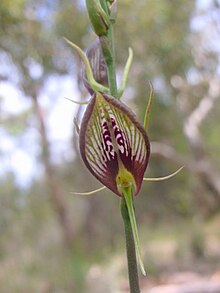Cryptostylis
| Tongue orchids | |
|---|---|

| |
| Cryptostylis erecta | |
| Scientific classification | |
| Kingdom: | Plantae |
| Clade: | Tracheophytes |
| Clade: | Angiosperms |
| Clade: | Monocots |
| Order: | Asparagales |
| Family: | Orchidaceae |
| Subfamily: | Orchidoideae |
| Tribe: | Diurideae |
| Subtribe: | Cryptostylidinae |
| Genus: | Cryptostylis R.Br. |
| Synonyms[1] | |
| |
Cryptostylis, commonly known as tongue orchids, is a
Description
Orchids in the
The
Taxonomy and naming
Cryptostylis was first formally described in 1810 by the prolific Scottish botanist, Robert Brown and the description was published in his book, Prodromus Florae Novae Hollandiae et Insulae Van Diemen. Brown described three species in the same publication (C. longifolia, C. ovata and C. erecta) but did not nominate a type species. (Cryptostylis longifolia is an illegitimate name and the species is now known as C. subulata.)[4][5]
The name Cryptostylis is derived from the Ancient Greek words kryptos meaning "hidden" and stylos meaning "pillar" or "column", referring to the column of these orchids which is partly hidden by the labellum.[2]
Molecular study of the DNA of tongue orchids shows the genus lies within the tribe Diurideae within the orchid family, having previously been considered part of the Cranichideae. The genera Cryptostylis and Coilochilus (endemic to New Caledonia) make up the subtribe Cryptostylidinae.[6]
Distribution and habitat
The genus comprises around twenty five species of terrestrial orchid distributed from
Ecology
All Australian species are pollinated by the ichneumon wasp known as the orchid dupe wasp (Lissopimpla excelsa). The male wasp mistakes the flower parts for a female wasp and attempts to copulate with it. Although the different species can occur together, they appear to inhibit cross-fertilisation and no hybrids are found in nature.[7] This discovery was made by Australian naturalist Edith Coleman in 1928, and the term coined was "pseudocopulation". The mimicking of flowers to resemble female wasp parts has since been recorded in other orchid genera but only in Cryptostylis has the insect been observed ejecting seminal fluid containing sperm cells. Coleman suggested that the males are more strongly attracted to the orchid flowers than to female wasps of the same species.[2][8][9] The flowers of Cryptostylis orchids and female wasp body parts are very similar in colour when viewed under a hymenopteran visual system, despite looking different to human eyes. Although the colours that ichneumon wasps see are unknown, bees and wasps have similar perception with green, blue and ultraviolet wavelengths.[10]
The Cryptostylis orchids are unusual in that several species are pollinated by the same wasp species; other orchids which mimic insects are often species-specific. The flowers have no smell detectable to humans, but have been shown to have an odour which attracts the orchid dupe wasp. Furthermore, gas chromatography and electrophysiology show that the single active compound for pollinator attraction is found in different species of Cryptostylis.[11]
Species
Species currently accepted as of July 2018:[1]
- Cryptostylis acutata J.J.Sm. - Java, Borneo, Sumatra
- Cryptostylis apiculata J.J.Sm. - New Guinea
- Cryptostylis arachnites (Blume) Hassk. in C.L.Blume - Guangdong, Guangxi, Taiwan, Cambodia, Assam, Indonesia, Laos, Malaysia, Myanmar, New Guinea, Philippines, Sri Lanka, Thailand, Laos, Myanmar, Vietnam, Andaman Islands, Solomon Islands, Fiji, New Caledonia, Samoa, Vanuatu
- Cryptostylis arfakensis J.J.Sm. - New Guinea
- Cryptostylis carinata J.J.Sm. - New Guinea
- Cryptostylis clemensii (Ames & C.Schweinf.) J.J.Sm. - Sabah
- Cryptostylis concava Schltr. - New Guinea
- Cryptostylis conspicua J.J.Sm. - Thailand, Malaysia, Java, Sumatra
- Cryptostylis erecta R.Br. - Queensland, New South Wales, Victoria
- Cryptostylis filiformis Blume - Java
- Cryptostylis gracilis Schltr. - New Guinea
- Cryptostylis hamadryas Schltr. - New Guinea
- Cryptostylis hunteriana Nicholls - Queensland, New South Wales, Victoria
- Cryptostylis javanica J.J.Sm. - Java
- Cryptostylis lancilabris Schltr. - New Guinea
- Cryptostylis leptochila F.Muell. ex Benth. - Queensland, New South Wales, Victoria, Tasmania
- Cryptostylis ligulata J.J.Sm. - New Guinea
- Cryptostylis maculata (J.J.Sm.) J.J.Sm. - New Guinea
- Cryptostylis ovata R.Br. - Western Australia
- Cryptostylis sigmoidea J.J.Sm. - New Guinea
- Cryptostylis sororia Schltr. - New Guinea
- Cryptostylis subulata (Labill.) Rchb.f. - Queensland, New South Wales, Victoria, Tasmania, South Australia, New Zealand North Island
- Cryptostylis taiwaniana Masam. - Taiwan, Philippine
See also
References
- ^ a b "Cryptostylis". World Checklist of Selected Plant Families (WCSP). Royal Botanic Gardens, Kew.
- ^ ISBN 0-19-850710-0. Retrieved 4 July 2018.
- ^ a b c Weston, Peter H. "Genus Cryptostylis". Royal Botanic Garden Sydney. Retrieved 4 July 2018.
- ^ "Cryptostylis". APNI. Retrieved 4 July 2018.
- ^ Brown, Robert (1810). Prodromus Florae Novae Hollandiae et Insulae Van Diemen. London. p. 317. Retrieved 4 July 2018.
- PMID 21669623.
- ISBN 0-521-45058-6. Retrieved 22 November 2010.
- ^ Peakall, Rod. "Pollination by Sexual Deception in Australian Terrestrial Orchids". Australian National University. Archived from the original on 13 September 2019. Retrieved 17 September 2019.
- S2CID 833763.
- S2CID 1729573.
- .
External links
 Media related to Cryptostylis at Wikimedia Commons
Media related to Cryptostylis at Wikimedia Commons
